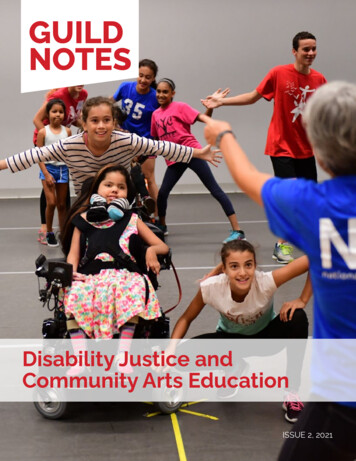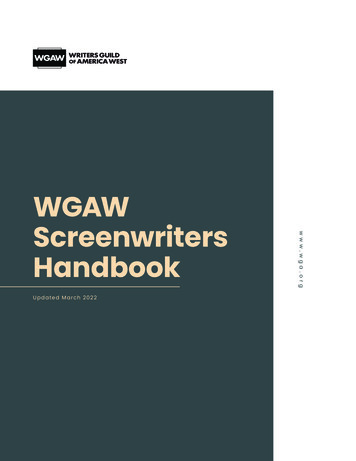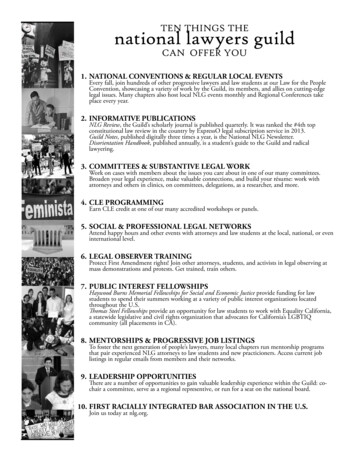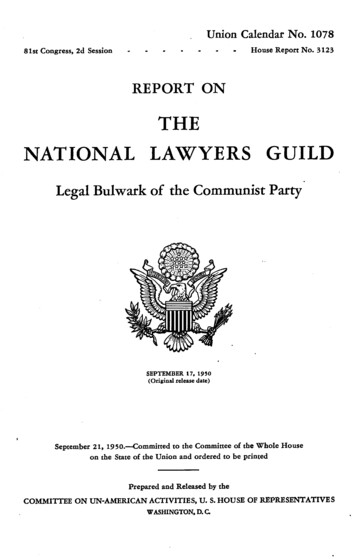
Transcription
GUILDNOTESDisability Justice andCommunity Arts EducationISSUE 2, 2021
NATIONAL GUILD FORCOMMUNITY ARTSEDUCATION520 Eighth Avenue, Suite 302New York, NY 10018212-268-3337www.nationalguild.orgAshley HareDEPUTY DIRECTOR OF EQUITYAND HUMAN DEVELOPMENTGuild NewsLetter from the Editor“Accessibility is a priority, not an afterthought.” –Rorri Burton, ProBono ASLWe, as community arts educators, cannot commit to anti-racism,anti-sexism, and anti-ageism without committing to disabilityjustice –and vice versa.Jasmine HuffLEARNING AND ENGAGEMENTMANAGERHeather IkemireDEPUTY DIRECTOR OF LEARNINGAND ENGAGEMENT1 and 4 Americans are living with a disability, and when youinclude “invisible” disabilities (such as mental health and learningdisabilities), the percentage increases. Further still, the likelihood,and impact, of living with a disability is disproportionately greaterfor Black people, people over the age of 65, and people inpoverty.Adam JohnstonDEPUTY DIRECTOR OF OPERATIONSRangsey KeoMEMBERSHIP AND OPERATIONSMANAGERAnd yet, too often in community arts education, people withdisabilities are treated as an afterthought, as Rorri cautions,in everything from our programs and meeting spaces toour storytelling and finances, to our leadership and equitywork. This issue of GuildNotes shares perspectives andtangible advice on how to change this harmful tendency andintentionally prioritize people with disabilities.Jenina PodulkaCOMMUNICATIONS MANAGERKate RileyDEVELOPMENT MANAGERNatalia VilelaCOMMUNICATIONS COORDINATORClaire WilmothMEMBER SERVICES AND DATA SYSTEMSMANAGERIvy YoungDIRECTOR OF CONFERENCES AND LEARNINGGUILDNOTES DESIGN: Farhan HossainEDITOR: Heather IkemireThe National Guild for Community Arts Educationworks with a broad range of individuals andorganizations to ensure all people have opportunitiesto maximize their creative potential. We accomplish thisby developing leaders, strengthening organizations,and advocating for community arts education. The Guildenvisions a nation in which arts education is accessibleand considered essential for human development andhealthy communities.ON THE COVER: NATIONAL DANCE INSTITUTE’S DREAMPROJECT, NEW YORK, NY. PHOTO BY EDUARDO PATINOPAGE 2, GuildNotes, Issue 2, 2021To be transparent, the Guild is still at the beginning of itsown anti-ableist journey. We have begun by investing instaff training, centering people with disabilities in someof our programmatic decision-making, and prioritizingthe time and resources necessary to provide ASLinterpretation and close captioning for our online learning.And for the first time, we are offering multiple versions ofthe articles in GuildNotes, including text only versions,an audio version of “Bridging Justice,” and a full, videorecording of the interview with Antoine Hunter (withASL and voice interpretation). These can all be foundin our online resource center. For 2022, GuildNotes willgo through a redesign to be more accessible for lowvision readers and those using screen readers.We are still learning and invite feedback. Pleasecontact us at programs@nationalguild.org with inputon how we can continue to improve our practice.In solidarity,Deputy Director of Learning and Engagement
Register Now for“Groundwork: Healing withinCommunity Arts Education”Deadline: Thursday, October 14Register now through October 14for the Guild’s online gathering,“Groundwork: Healing withinCommunity Arts Education.”Designed in collaboration with ourcommunity advisors and sessionreviewers, Groundwork will providespace for people in communityarts education to embody radicalreinvention and imagination as weprocess the pandemic. Throughcreative artmaking, learning,and connection, we will tend toourselves, our collectives, and ourvision of a transformed society.We encourage you to register witha group from your community—including with fellow artsadministrators, teaching artists,young creatives, and programpartners—to share the learningand bring back new insights andinspiration to your collective work.To make our programs accessible toeveryone, we are using a privilegebased sliding scale pricing modelthat includes a “pay what you can”and a “solidarity donation” option. Wealso offer the opportunity, througha solidarity donation, to redistributewealth towards someone in yourcommunity that would not otherwisebe able to access services.Groundwork runs for 3 weeks(October 18–November 5) and youmay choose your own learningtracks. Each week will kick off witha General Assembly session ona different dimension of healing,featuring storytellers and practicesfrom across the country. We theninvite you to join us for one of ourlearning tracks on the followingafternoons (Eastern Time) each week:Creative Aging (Tuesdays), HumanCentered Practices (Wednesdays),and/or Creative Youth Development(Thursdays).Learn more and register!AccessibilityExpansion & Restructuringof the Guild’s ExecutiveLeadership TeamThe Guild is well on its way with thenational search process for a newExecutive Director. Thanks to all whohave supported us in the processand in sharing the job posting.During this time of transition, Guildstaff have been working daily tocontinue our movement towardsbecoming an anti-racist organization.As we build a practice oftransparency and storytelling aboutthis journey, we’d like to share somechanges to our executive leadershipstructure that we have implemented.The National Guild will practiceand model audio descriptions andsupport speakers in this practicefor describing themselves andvisual content. Additionally for liveevents, the Guild will provide ASLinterpretation and closed captioning.If you have any otheraccommodation requests andaccessibility needs, please contactIvy Young, Director of Conferencesand Learning, at ivyyoung@nationalguild.org.We have removed the word“Chief” from executiveleadership titles. In multipleconversations with Indigenous andFirst Nation peoples, we’ve heardvarying thoughts on whetherthe use of “Chief” is harmful. Webelieve that if it’s harmful to one,then we shouldn’t use it at all.We have decided to eliminatethe language of “Chief Officer”from the titles of our executiveleadership team. Now, HeatherIkemire is the Deputy Director ofLearning and Engagement, AdamJohnston is the Deputy Directorof Operations, and CEO has beenretitled to Executive Director.We have expanded theexecutive leadership team toinclude the position of DeputyPAGE 3, GuildNotes, Issue 2, 2021
Guild NewsAshley HareDirector of Equity and HumanDevelopment. Ashley Hare(previously the Director ofLeadership Development) hasbeen promoted to this role.Ashley is the first self-identifiedperson of color to join the Guild’sexecutive leadership team.In a recent blog post, Ashleyshares their personal perspectiveon these changes, and how thechanges relate to larger patternswithin the nonprofit world—aswell as recommendations to otherorganizations considering makingsimilar shifts.Guild Stands with theNational Progressive ArtsEducation Coalition andEncourages Town HallParticipationIn a June statement, the ArtsEducation Council (which formerlyserved as an advisory to Americansfor the Arts (AFTA)) spoke out aboutAFTA’s lack of transparency in theirfailure to disclose findings from theirrecent investigation, and their lackof field engagement throughoutthe process since the council firstissued a call for accountability andlist of demands to AFTA in December2020. The Arts Education Councilwill now transform from an advisoryPAGE 4, GuildNotes, Issue 2, 2021council affiliated with and in serviceto AFTA, into a national ProgressiveArts Education Coalition workingwith leaders across the countryto advance a more equitable artseducation, creative economy, andcultural sector. They held an opennational town hall on Monday,September 13, during the NationalArts in Education Week (September12–18) to refine a set of valuesand a national agenda for the artseducation field. You can sign upfor their mailing list to get updatesfollowing the Town Hall.The National Guild agrees with allpoints raised about continued lackof accountability and transparency,and looks forward to seeingthe Progressive Arts EducationCoalition’s next steps take shape. Ourpartnership with (and membershipto) AFTA continue to be ceaseduntil we see true accountability andchange.Welcome to Jasmine Huff andNatalia Vilela!Jasmine HuffNatalia Vilela“All Our Yesterdays”: A BriefHistory of the GuildLolita Mayadas, former ExecutiveDirector of the National Guild,has written a history of the Guildfrom 1967–2001 called “All OurYesterdays”. From the book’sdescription: “Written in a style thatis part-history and part-memoir,this book takes the reader throughperiods of great stress when theassociation might well have folded.At the same time, the vision anddetermination of its leaders wereinstrumental in keeping the torch lit,resulting in significant achievements.”Mayadas’s book is available now atBarnes & Noble and Amazon.We are thrilled to welcome two newstaff members to the Guild’s Learningand Engagement team, JasmineHuff and Natalia Vilela.Jasmine (she/her) is our newLearning and Engagement Managerleading efforts to develop ournew online forum, CommunityConversations, and other networkingprograms, as well as supportingongoing learning opportunities.Based in Winston-Salem, NorthCarolina. An intuitive visual artist,Jasmine Huff started her careerearly. As the product of an artisticfamily, she exhibited and sold herart, photography and jewelry in
her family’s gallery, Huff Art Studio.At nineteen, she graduated fromSalem College where she earnedher Bachelor’s Degree in Film andMedia Studies. She continued herstudies at Northwestern Universitywhere she graduated with a Masterof Fine Arts in Documentary Media in2016. In recent years, she has beenteaching film courses, exhibiting herphotography and assisting with artprojects within her local community.Jasmine aims to bring her history asan artist and educator to her newposition within the Guild.Natalia (she/they) is excitedto join the National Guild teamremotely from Long Beach, NewYork. She is working with us this fallas Communications Coordinator,supporting our virtual gathering,“Groundwork: Healing withinCommunity Arts Education,” socialmedia engagement, and othercommunications efforts. Nataliais a knowledge-hungry PeruvianAmerican with a longtime interestin graphic design and communityempowering initiatives. She strivesto amplify such initiatives viacommunicative visuals, and aims topromote work that captivates thosewho proudly strengthen others. Oneof their most recent experienceswithin the nonprofit realm involvesworking as the CommunicationsAssistant for the migrant rightsnonprofit Justice in Motion. Nataliaholds a B.A. in Journalism fromHofstra University and a certificatefrom the Shillington School ofGraphic Design.National Guild Resources for “Reopening”The following are recommended National Guild resources from the pastyear and a half to help you and your collaborators navigate what it meansto “reopen” in the fall and beyond amid continued uncertainty. Manyof these Resources are hosted in the Guild’s online Resource Center.Additional resources will be shared as part of Groundwork!.Covid Response Series: This 12-part series from April 2020 sharesperspectives from various people in the field on human-centeredapproaches to navigating the pandemic and to transitioning to onlineprogramming effectively and equitably. Select “Covid-19 Crisis” underInterests.Anti-Racism as Organizational Compass Series: A series sharingintimate conversations with BIPOC-led arts organizations that centeranti-racism in mission and practice. Search “Social Justice” underInterests.Pillars of Embedded Community Practice (read here): This tool wasmade via a series of conversations amongst the Rootwork Cohort, aprogram of the National Guild, that convened from November 2020–April 2021.Rootwork: Grounding Community Arts Education Beyond thePandemic (members only): A 9-part series that shares community artseducation practices that are informed by, and supportive of, the manyvaried lived experiences of our communities in the unique context ofour current moment. Select “Covid-19 Crisis” under Interests.Thriving Better Together: Creative Aging & Resilience (membersonly): A 3-part series about creative aging programs, how socialisolation impacts elders, and the advocacy needed to address ageismand other forms of oppression within the arts and culture sector. Select“Creative Aging” under Interests.2019 National Guild Benchmarking Data Report (Available forpurchase; free for those that participated in the survey --pleasecontact programs@nationalguild.org): While the data aggregated inthis report is pre-Covid data, the report provides valuable informationon staff and faculty compensation, instructional fees, income andexpense ratios, and more—that can inform your current planning andbudgeting and help funders and policy makers better understandthe needs and impact of our field. The data, gathered from 179 Guildmember organizations, is presented in easy to read charts and tables.For the first time, the report also includes sections on racial equity,creative aging, and analysis of salary information by organization type,type of community served, and organizational budget size.Accessibility Practices for Zoom MeetingsGuild staff has developed a tip sheet for staff and collaborators outliningkey accessibility practices for preparing and facilitating Zoom meetings,programs, and classes. A copy of the tip sheet is featured onpage 10.PAGE 5, GuildNotes, Issue 2, 2021
Thanks to Our 2020 Supporters!2020 was a year of reckoning with many assumptions. The growing movement of community-centered fundraisingis providing a theoretical framework for the Guild to bring our own fundraising practices into stronger alignment withour Racial Equity Guiding Principles and Policies. We are grateful for every contribution we received last year andhave identified three values we’d like to uplift: loyalty, time, and financial support. The Guild, therefore, is removinggiving levels from our 2020 donor listing to illustrate that every donation is deeply valued, regardless of the donor’sgiving capacity. In addition, we will make note of the service provided by our trustees and trustee emeriti, andshine a light on donors who have given consistently for the last 10 years or more. We welcome you to be part of theconversation with the Guild and learn more about our internal transformation.To all who gave, we thank you.While every effort has been made to record all financial contributions, it’s come to our attention some of our mail hasbeen misdirected. If your contribution is missing from this list, please email kateriley@nationalguild.orgKEYa Member of Board of Trusteesd Trustee EmeritusDuffie Adelson a gChad Cooper and Claire Ellis aAlchemy, Inc.Emilie Corey dBurton Alter and Lisa HorowitzgDavid CorryAmerican ExpressAngell FoundationAnonymous Donor (10)Elizabeth Applegate - InHonor of Peter R. KleinerAroha PhilanthropiesCarl and Deborah Atkins d gJohn Culhane - In Memory ofDorothy Jean CulhaneRachael Cullins - In Honor ofNoelle RussellSummer Delaney & NicholasFinemanEric Delli Bovi aJoyce DraytonPatricia BanksBenjamin Dunham and WendyRolfe-Dunham gMary L. Bianco at The MOCAFoundationHelen Eaton and GuillaumeCombet aCathy BlightTeresa and David EhrlichEric BoothPhyllis FederSandra Bowie aAndrea Fineberg - In Honor ofIvy YoungLinda Burt gg 10 or more years’ support of the GuildAnn and Gordon GettyFoundationBarry Goldberg gPriscilla Kane Hellweg andJohn HellwegThe Good BeginningThora JacobsonLaurie GrantJohn KnetemannAshley HareLydia Kontos gStephen and Ann MarieHaymesLee Koonce a gKatie and Chris HemphillJonathan Herman g In Honorof Duffie Adelson and theNational Guild staffDan Herman gCherie HillJulia HoffmanSarai HoffmanLiisa KylhekuKaren LaShelle aSoYoung Lee aJeffrey LupardoLolita and Azim Mayadas gToby Mayman d gCynthia Miller gTerry Hueneke d dGayle Morgan and EdwardEllien a gLili Hussey aMusic Man FoundationNational Endowment for theArtsRoma Calatayud-Stocks andThomas Stocks aPaul Noel Fiorino - In Honorof Hearts For The Arts OfColoradoKimberly HyattJoseph Campbell FoundationSofia Fojas aSachiko IsiharaClare Rose FoundationDerrick Gay aDarren Isom aPAGE 6, GuildNotes, Issue 2, 2021Judith IstockLarry IsbergNegaunee FoundationHeather Nelson
Scott and Barbara Nelson- In Honor of Kate & ShaneDriscollMarie TaiDenise BrandenburgBahia RamosLeslie ThomasRichard BrownKwame ScruggsNew York City Department ofCultural AffairsPamela TriminghamSharon BryantTom CampMay van ScherrenburgRobyn Newhouse a gJason TrottaMatt D’ArrigoNancy Ng a gU.S. Small BusinessAssociationCorie Nichols gErnest VialpandoSarah DrebelisMyran Parker-Brass aThe Wallace FoundationKate FoxJulienne Penza-Boone gJ. Curtis Warner Jr. aRebecca GnessinG. David Peters a gLecolion Washington aAyanna HudsonPeggy Quackenbush gConstance WatsonLindsay LewisHilary Respass gLawrence Zukof d gSarah LydingMartha Rochelle aThe Guild would like toelevate the individuals who— on behalf of institutions —authentically collaboratedwith us to ensure we had theresources required to emergemore resilient from thisdifficult time:Joyce LyonsCarol Ross d gRay Rusnak d gLaurie RussellKatherine Schumacher d gNina Stillman a gMary BiancoTeresa BonnerLisa DelanJames McClellandKatie McKenzieAfter 25 years, CEO JonathanHerman has retired from theGuild. And while we hope togather in person to celebratehis legacy someday, we weretouched by those who madegifts in his honor:Linda BurtBarry GoldbergSarai HoffmanToby MaymanPeggy QuackenbushCarol RossLawrence ZukofJessica MeleEllen MichelsonSuzanne PakiSanta Barbara Dance Institute. Photo by Dave Bazemore.PAGE 7, GuildNotes, Issue 2, 2021
New MembersHelp Us Welcome Our 2021 New Guild MembersSince January 1, the following organizations and individuals have joined the Guild in 2021! Please join us in welcomingthem to our learning community. To learn more about our members, visit the Guild’s online Member Directory orcontact Guild staff to help you connect with organizations or individuals. We will continue to update you on newmembers this fall!Organizational MembersHouston Ballet, Houston, TXSedona Arts Center, Sedona, AZAlaskan Storyteller, Anchorage, AKInclusive Arts Vermont, Essex Jct., VTAmerican Recorder Society,Charlotte, NCIndigo Cultural Center, Phoenix, AZSouth Gate Cultural Arts,South Gate, CAArtsConnection, New York, NYBaldwin Wallace University,Community Arts School, Berea, OHJosephine Herrick Project,New York, NYJoshua’s Stage, Austin, TXBoston Music Project, Boston, MALincoln Center Education, New York,New YorkChicago Youth Shakespeare,Chicago, ILLouisville Academy of Music,Louisville, KYColorado Springs Conservatory,Colorado Springs, COMaryland State Department ofEducation, Office of Fine Arts,Baltimore, MDCome On, Let’s Sing!,Forest Grove, ORCommunity Music School of Raleigh,Raleigh, NCCommunity School of the Arts (ISU),Terre Haute, INCommunity School of the Arts atAPSU, Clarksville, TNCreative Aging Network-NC,Greensboro, NCEmpowering Communities ThroughArt, Albany, NYGirl Be Heard, Brooklyn, NYGuardians for the Arts, Ofallon, MSHarmony Program, New York, NYHarmony School of Creative Arts,Marble Falls, TXPAGE 8, GuildNotes, Issue 2, 2021Midland Community Theatre,Midland, TXNevada School of the Arts, LasVegas, NVOpera Omaha EngagementPrograms, Omaha, NEPerkins Center for the Arts,Morristown, NJPioneer Valley Symphony,Greenfield, MAPittsburgh Center for Arts and Media,Pittsburgh, PAPrimeLife Arts Learning,Minneapolis, MNRecording, Radio, Film Connection,Los Angeles, CASan Francisco Conservatory of Music,San Francisco, CATeachers & Writers Collaborative,New York, NYThe Empowerment Factory,Pawtucket, RIVineyard Artists, Lexington, MAWestminster Conservatory of Music,Princeton, NJWorking Classroom, Albuquerque,NMWriters & Books, Rochester, NYYouth in Arts, San Rafael, CAIndividual MembersGabriel Hourticolon, Baltimore, MDHussein Al-Nasrawi, Pleasant Hill, CAAltesa Baker, Northridge, CAMylene Cahambing, Oakland, CACassandra Clark, Somers, NYCori Crooks, Philadelphia, PAChantara Ellis, Brooklyn, NYAlaina Hall, Mexico, NYCarol Harkins, Tulalip, WASherri Hauser-Simmons, Fairburn, GAFarhan Hossain, San Diego, CA
Sphinx Organization, Sphinx Overture recital,Detroit Community Schools - Elementary, Detroit MI.Calida Jones, Windsor, CTAllida Warn, Jamaica Plain, MAEunji Kim, Lynwood, CADeborah Waters Smith, Champaign,ILTammarrah Lee, Boston, MARachel Lerberg, Arlington, TXCarrisa Matsushima, Norristown, PAKennedy Pugh, Pueblo, COKristin Wilder, Warne, NCTrudy Williams, Leeds, MABusiness AffiliateJames Rolling, Manlius, NYG2 Insurance Services, SanFrancisco, CAMackie Saylor, Long Island City, NYArts Consulting Group, Boston, MABep Schippers, London, ONHeather Smith, Centerville, UTPay What YouCan MembershipNot yet a member?Guild membershipis currently paywhat-you-can.Learn more aboutthe benefits ofmembership here.Mary Smith, Brooklyn Center, MNIrene Thomas-Jacks, San Francisco,CAAnn Thompson, Biddeford, MEHeidi Turnquist, Eugene, ORPAGE 9, GuildNotes, Issue 2, 2021
Accessibility Practices forZoom MeetingsBefore the Meeting.Bring headphones toensure the best sound & tocut out background noisesTest your speakers andmicrophones to make surethey work properlyChoose a simple live orvirtual backgroundProvide enough lighting tocreate contrast betweenyou and your backgroundPractice speaking moreslowly and clearly thanyour usual speaking paceSend slides to participantsahead of timeDon't wear long earringsthat can bump up againstyour microphoneDuring the Meeting.Describe yourself and the setting during the firstintroduction (What are your physical features?What are you wearing? What does yourbackground look like?)Introduce your name each time you speakunless a question is directed to youDescribe what is on screen if you share aPowerPoint or any other visual contentSpeak slowly and clearly, using more pausesthan you think you needStay on mute when you're not speaking topreserve sound qualityIf you are leading the meeting, share youragenda or plan for the meeting time will allattendeesIf you are leading the meeting, provide a shortbreak for meetings that exceed 40 minutesREMEMBER THESEPRACTICES ARE HELPFULFOR ALL PEOPLE IN ALLMEETINGSResources (hyperlinked below)9 Ways to Make Your Webinars and Meetings More AccessibleEnsuring Virtual Events Are Accessible for AllAccessible webinars – making online work for everyoneBest video conferencing apps and software for accessibilityChoosing the best custom video backgrounds for low vision audiencesHow to create accessible PowerPointsUniversal Design 101PAGE 10, GuildNotes, Issue 2, 2021
Centering Anti-Ableism inCreative Aging ProgramsBy Ellen HirzyHyde Park Art Center’s Collage Chicago program, Chicago, IL.Conversations about social justiceoften overlook two systemic issues:ageism and ableism. More thanone in seven Americans are olderthan age 65 and two in five of thosehave some form of disability, but weperpetuate biases and behaviors thatstigmatize both aging and disability.“We’re being ageist anytime wejudge someone based on howold we think they are, and ableistwhen we judge them based on howwe assume their minds or bodiesfunction,” says anti-ageism activistand writer Ashton Applewhite. Andageism and ableism frequentlyoverlap. “We’re being ageist andableist when we attribute capacity—or incapacity—to someone based ontheir age. And an ageist and ableistculture gives us cover. That has tochange.”Ableism is embedded in typicalmodels of “positive,” “successful,”or “healthy” aging, which reinforcestereotypes of older adults withdisabilities. “The preferred way ofbeing old is to not be old at all,but rather to maintain some imageof middle-age functionality andappearance,” say gerontologistsClara W. Berridge and MartyMartinson. This is an ageist andableist way of thinking. There’snothing unusual or abnormal aboutliving with the physical and cognitivechanges that are unique to eachindividual and part of the natural,lifelong aging process. When wedon’t acknowledge this reality anddesign for inclusivity in our programsand approaches, we set older adultsup to fail. Berridge and Martinsonsuggest a different approach: “Byacknowledging and valuing disabilityas part of the diverse experience ofaging, we are better able to revealthe human potential of old age.”Creative aging programs incommunity arts education havethe opportunity to work at theintersection of anti-ageism andanti-ableism. They can be antiageist because they focus on artslearning and skill building for olderpeople. They take place in engaging,supportive environments whereolder adults are valued as active,capable learners and creators withtalent, drive, and commitment. TheyPAGE 11, GuildNotes, Issue 2, 2021
also can be anti-ableist because theirapproach to teaching and learningis asset based, not deficit based.Organizations and practitionersidentify physical, perceptual, andlogistical barriers to engagementand work to remove them.These programs are leadinga cultural shift toward greaterunderstanding of anti-ageistpractice, says Nathan Majoros,deputy director of Lifetime Arts,which partners with the NationalGuild in its Catalyzing Creative Aginginitiative. They’re also becomingmore intentional about anti-ableism,access, and inclusion, “but there’sstill work to be done.” The “healthyaging” frameworks that Berridgeand Martinson describe inform manycreative aging models, especiallythose that describe programaudiences as “active” older adults,and this kind of language leveragesableism. But once practitionersWe’re being ageistand ableist when weattribute capacity—or incapacity—tosomeone based ontheir age.ASHTON APPLEWHITEbegin to think about anti-ableism,they see the physical and perceptualbarriers to participation and focusArt League Houston’s Healing Art program, Houston, TX. Photo by Alex Barber.PAGE 12, GuildNotes, Issue 2, 2021on how to remove them. “There’s alot of experimenting, but the workis intersectional,” Majoros says.“Organizations can tackle bothageism and ableism together.” Usingan anti-ageist and anti-ableist lens,there’s great potential for movingfrom intention to action.Cynthia Edmondson’s experiencetells us what works for older adultartists with disabilities. At 79, shelives with multiple sclerosis. Art hasbeen part of her life since childhood,but her time for creating art waslimited during her working years.She began to paint again for the firsttime in several decades when shejoined Healing Art, a program at ArtLeague Houston designed for adultswith physical disabilities and illness.“Painting again was scary at first,”
Newark School of the Arts, Newark, NJ.she says, but the program was “veryaccepting. I’ve just loved it.”Edmondson uses a rollator to getaround, and even though the classspace at Healing Art can be a bitcrowded, the program staff hasfigured out how to meet her needs.And as the fine motor skills in herdominant right hand declined,teaching artists helped her learn topaint with her left hand. She says“it has worked out fine”--a modestunderstatement.Edmondson’s work has been shownregularly in Healing Art’s studentexhibitions. She explores abstractionwith some figural aspects, weavingthemes from her varied lifeexperiences into her paintings, whichalso show her interest experimentingwith texture. Edmondson says sheespecially values the atmosphereof acceptance and the supportivecommunity of peers at HealingArt. Teaching artists are flexible,adapting their approaches to suitvaried individual needs and creativeinterests. Students range frombeginners to artists with considerabletraining and experience, but theyrespect each other’s artistic practice.“I’ve found a group I can relateto and a connection to other lifeexperiences. We know that we’reall dealing with long-term healthissues, but we rarely talk aboutthat.” Her advice: Select the rightteaching artists, create a welcoming,nonjudgmental culture, and focus onlearning and making art.WORK IN A COMMUNITYARTS EDUCATIONORGANIZATION?WHAT ARE THECHARACTERISTICS OFSUCCESSFUL ANTI-ABLEISTAn active voice for older adultsSystemic commitment to inclusionDisability justice, including inclusionof older adults with varying abilities,is central to the mission. It’s notjust an education program, but anorganizational value that’s basedon a deep dive into why inclusion isessential. Evaluation shows that olderadults see the transformative powerof learning and the joy of acquiringnew skills. But without the underlyingphilosophical drive, Majoros says,“organizations and teaching artistsdon’t see the value in continuing thework.”Older adults with disabilities have astrong sense of ownership becausePAGE 13, GuildNotes, Issue 2, 2021
Cerámica: Cuentos Para Las Generaciones/Ceramics: Stories for the Ages” at Fleisher Art Memorial, Philadelphia, PA. Photo byDominic Mercier.they are consistently at the tablewhen decisions are made. Thestaff regularly engages them inprogram design, planning, andimplementation and consults themwhen developing inclusive, antiageist and anti-ableist practices.Assessment is built into programdesign so that program participantshave opportunities to report whatworks, what doesn’t work, and howthe organization and teaching artistscan better meet their needs.Willingness to acknowledge andconfront implicit biasThe starting point for anti-ageistand anti-ableist work—as with anysocial justice work—is to addressour own prejudices as individuals.“From childhood on, we internalizemessages about how awful it is toPAGE 14, GuildNotes, Issue 2, 2021grow old, and how awful it is to havea disability,” Applewhite says. Wehold negative and limiting viewseven though we can see olderpeople all around us who defythe myths and stereotypes. Olderpeople are not all alike. Dismantlingthose views is necessary, and i
PAGE 2, GuildNotes, Issue 2, 2021 NATIONAL GUILD FOR COMMUNITY ARTS EDUCATION 520 Eighth Avenue, Suite 302 New York, NY 10018 212-268-3337 www.nationalguild.org










